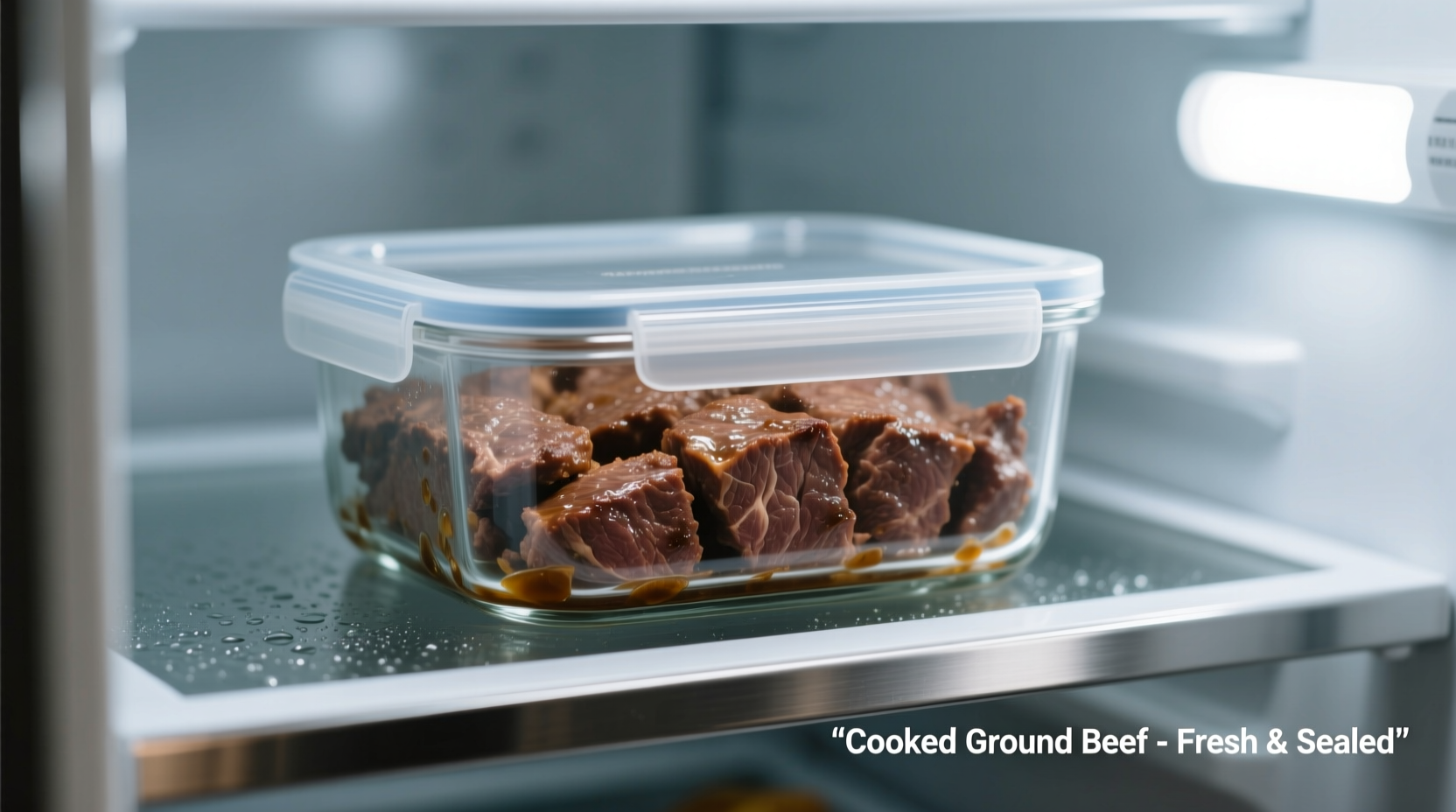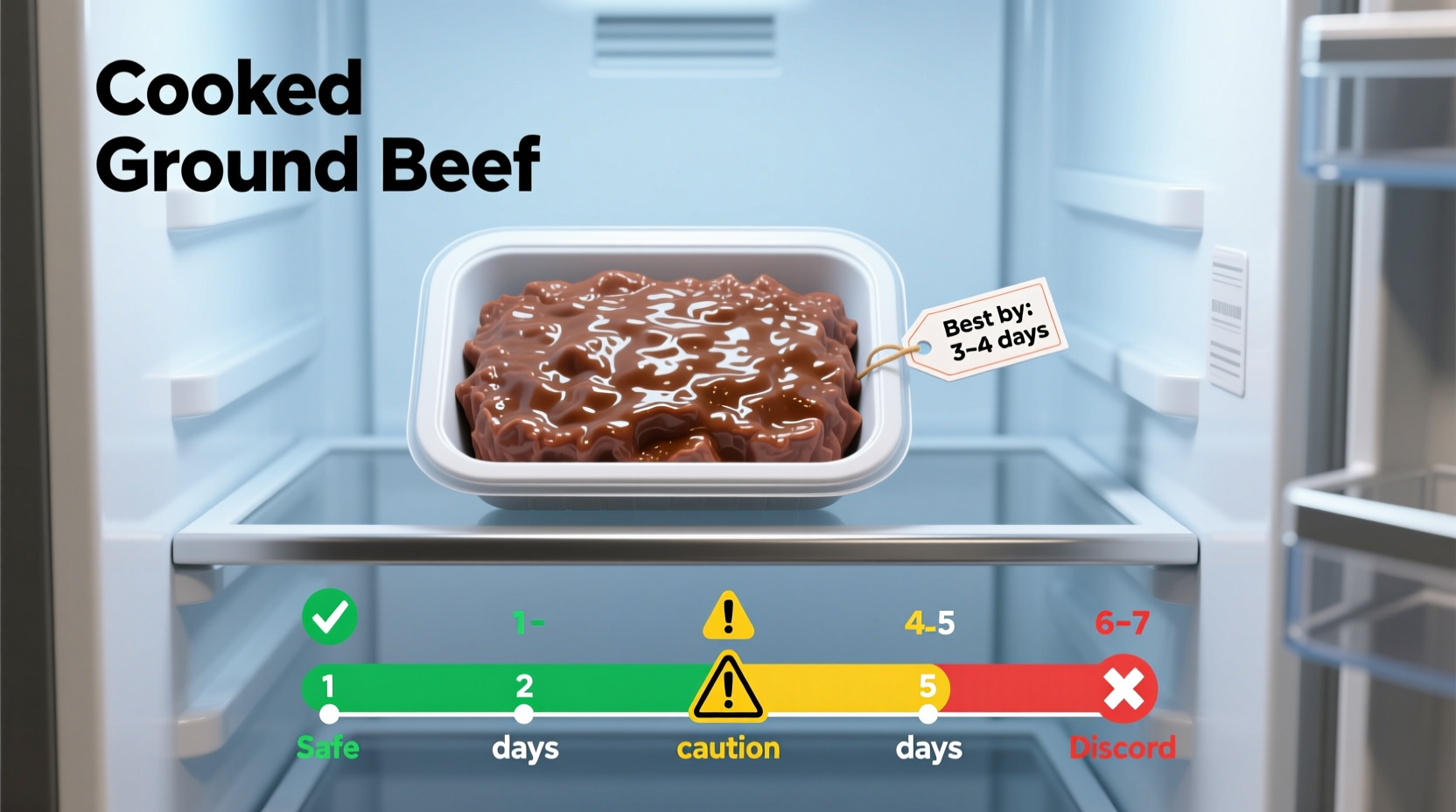Ever pulled questionable leftovers from your fridge, wondering if that cooked ground beef is still safe to eat? You're not alone. Each year, millions of Americans face this dilemma, potentially risking foodborne illness or unnecessarily tossing perfectly good food. Understanding the precise shelf life of cooked ground beef isn't just about convenience—it's a critical food safety practice that protects your health and your wallet.
Why the 3-4 Day Rule Matters for Cooked Ground Beef
Ground beef presents unique food safety challenges compared to whole cuts of meat. The grinding process distributes surface bacteria throughout the product, creating more opportunities for pathogens like Salmonella and E. coli to multiply during storage. When cooked properly to 160°F (71°C), these bacteria are destroyed—but new contamination can occur during handling, and spoilage bacteria continue growing at refrigerator temperatures.
The USDA's Food Safety and Inspection Service established the 3-4 day guideline based on extensive research into bacterial growth rates in cooked meats. While some bacteria grow slowly at proper refrigerator temperatures (40°F/4°C or below), Staphylococcus aureus and other pathogens can reach dangerous levels within this timeframe, especially if temperature fluctuations occur.
| Cooked Meat Type | Refrigerator Storage (40°F or below) | Freezer Storage (0°F or below) |
|---|---|---|
| Cooked ground beef | 3-4 days | 2-3 months |
| Cooked whole cuts (steak, roast) | 3-5 days | 2-3 months |
| Cooked poultry | 3-4 days | 4 months |
| Cooked fish | 3-4 days | 3 months |
Source: USDA Food Safety and Inspection Service, Leftovers and Food Safety
Maximizing Freshness: Your Step-by-Step Cooling Protocol
How you handle cooked ground beef immediately after cooking significantly impacts its safe storage duration. Follow this cooling protocol to maximize freshness:
- Cool rapidly: Divide large batches into shallow containers (no more than 2 inches deep) to cool faster. The USDA recommends cooling food from 140°F to 70°F within 2 hours, and from 70°F to 40°F within another 2 hours.
- Use proper containers: Transfer cooled ground beef to airtight containers or wrap tightly with heavy-duty aluminum foil or plastic wrap. Glass containers with tight seals work particularly well.
- Label everything: Note the date of cooking on the container using a waterproof marker. This simple step eliminates guesswork later.
- Store strategically: Place containers on middle or upper shelves where temperatures are most consistent, avoiding the refrigerator door where temperatures fluctuate.

When in Doubt: The Four Sensory Checks for Spoilage
While the 3-4 day rule provides a safety baseline, actual shelf life can vary based on your specific refrigerator conditions and handling practices. Before consuming, perform these four sensory checks:
- Smell test: Fresh cooked ground beef has a mild, meaty aroma. Discard if you detect sour, ammonia-like, or rotten egg odors.
- Texture check: Properly stored ground beef should feel moist but not slimy. Any sticky or slippery film indicates bacterial growth.
- Visual inspection: Look for grayish-brown discoloration throughout (not just on the surface). While surface browning is normal, pervasive discoloration suggests spoilage.
- Time verification: If you're uncertain about storage duration, follow the "when in doubt, throw it out" principle. Never taste questionable meat to check safety.
Remember that harmful bacteria like Listeria often don't produce noticeable odors or visible changes. The CDC reports that Listeria can grow at refrigerator temperatures, making strict adherence to storage timelines particularly important for at-risk populations including pregnant women, older adults, and immunocompromised individuals.
Avoiding Common Storage Mistakes
Even with the correct timeline knowledge, these common errors can shorten your cooked ground beef's safe storage period:
- Leaving food at room temperature too long: The "danger zone" between 40°F and 140°F allows bacteria to double every 20 minutes. Never leave cooked ground beef out for more than 2 hours (1 hour if room temperature exceeds 90°F).
- Using improper containers: Takeout containers with loose-fitting lids or flimsy plastic containers allow air exposure that accelerates spoilage.
- Storing while still hot: Placing warm food directly in the refrigerator raises the internal temperature, potentially compromising other stored items.
- Freezing after the 4-day window: Freezing stops but doesn't reverse bacterial growth. Freezing ground beef that's already been refrigerated for 5 days doesn't make it safe to eat later.
Extending Shelf Life Safely: Freezing Guidelines
When you can't consume cooked ground beef within 3-4 days, freezing provides a safe extension. For optimal quality:
- Portion into meal-sized amounts before freezing
- Use freezer-safe containers or heavy-duty freezer bags
- Remove as much air as possible from packaging
- Label with contents and date
- Consume within 2-3 months for best quality
Thaw frozen cooked ground beef safely by placing it in the refrigerator overnight, using the microwave's defrost setting, or submerging sealed packages in cold water (changing water every 30 minutes). Never thaw at room temperature.
Food Safety Timeline: From Cooking to Consumption
Understanding the complete food safety timeline helps prevent common mistakes:
- Cooking phase: Heat ground beef to 160°F (71°C) as measured by a food thermometer
- Cooling phase: Reduce temperature from 140°F to 40°F within 4 hours using shallow containers
- Refrigeration phase: Store at 40°F or below for maximum 3-4 days
- Reheating phase: Heat leftovers to 165°F (74°C) before consumption
This timeline, verified by the FDA Food Code and USDA guidelines, creates multiple safety checkpoints that collectively protect against foodborne illness. Temperature abuse at any stage compromises the entire safety chain.
Special Considerations for Different Kitchen Environments
While the 3-4 day rule applies universally, your specific kitchen conditions may require adjustments:
- Older refrigerators: Units over 10 years old may have less consistent temperatures. Use an independent refrigerator thermometer to verify actual temperature.
- Power fluctuations: During heat waves or storms, refrigerator temperatures may rise. When in doubt about temperature stability, shorten the storage window.
- Meal prep scenarios: When cooking large batches for weekly meals, cool portions immediately after cooking rather than waiting until all cooking is complete.
- Vacation planning: If traveling, either consume or freeze cooked ground beef before departure—don't rely on refrigerator safety during extended absences.
University extension programs like those from Cornell and Michigan State have documented how minor temperature fluctuations significantly impact bacterial growth rates. Their research shows that just one hour above 45°F can reduce the safe storage window by nearly a full day.
When Leftovers Become a Health Risk
Consuming cooked ground beef beyond its safe storage window risks several foodborne illnesses:
- Staphylococcal food poisoning: Caused by Staphylococcus aureus, symptoms appear within 30 minutes to 8 hours
- Listeriosis: Caused by Listeria monocytogenes, particularly dangerous for pregnant women and immunocompromised individuals
- Salmonellosis: Caused by Salmonella, symptoms typically appear 6 hours to 6 days after consumption
The economic impact of foodborne illness is substantial—the USDA estimates that foodborne illnesses cost the American economy between $15.5 and $15.6 billion annually in medical expenses and lost productivity. Following proper storage guidelines isn't just about individual health; it contributes to broader public health and economic stability.











 浙公网安备
33010002000092号
浙公网安备
33010002000092号 浙B2-20120091-4
浙B2-20120091-4